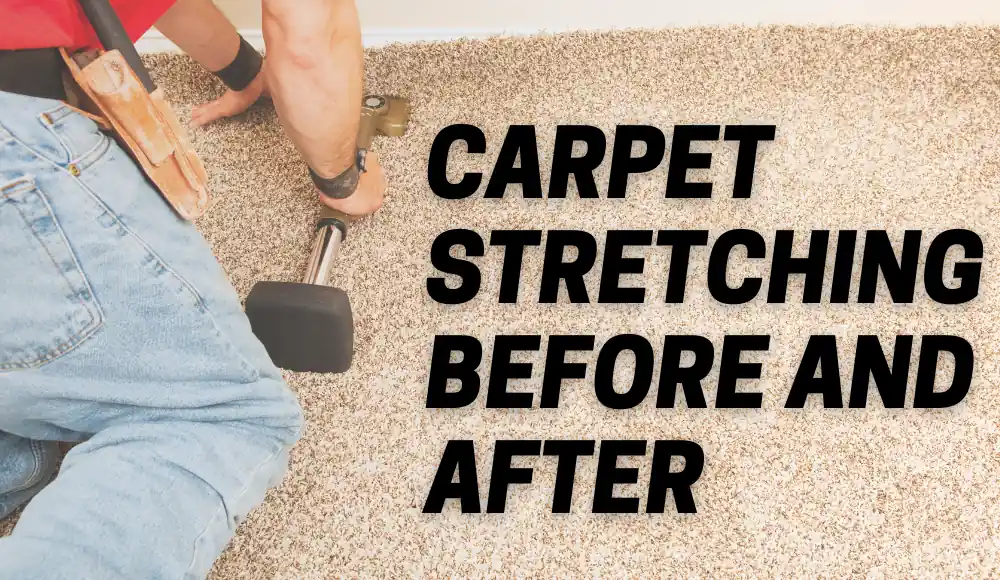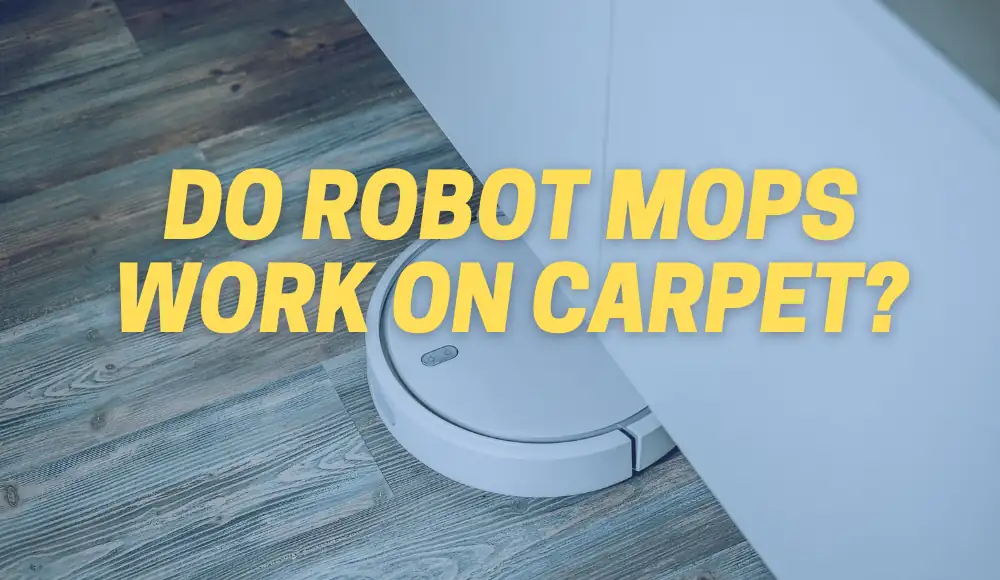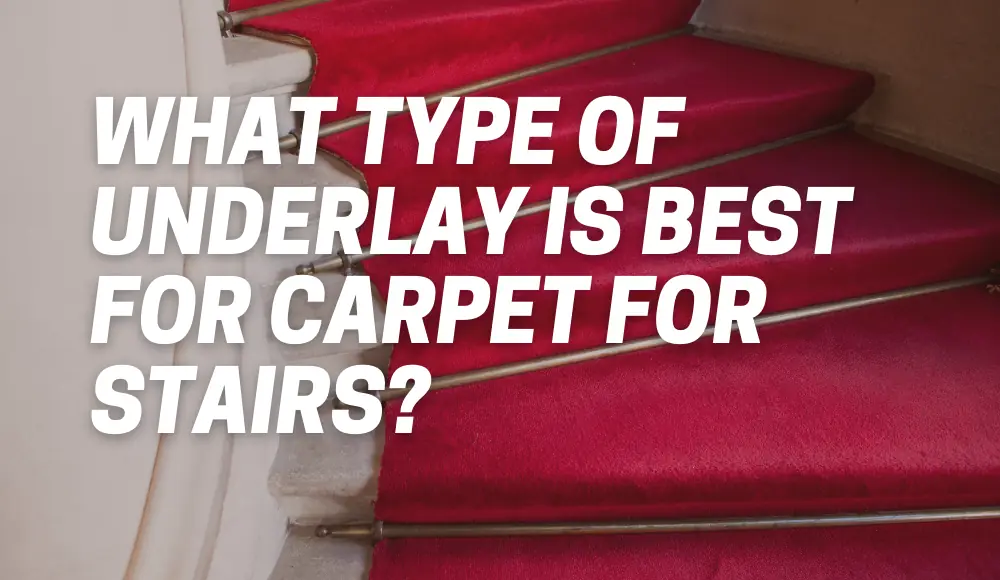If you’re planning on installing a new carpet in your home, you might be wondering about the best way to ensure it lasts as long as possible. You may have heard of carpet stretching, but aren’t exactly sure what it entails and if there is a difference between the carpet stretching before and after.
Simply put, carpet stretching is the process of stretching your carpet tightly across a room’s subfloor, without any wrinkles or bumps. It ensures that your carpet lays flat and looks aesthetically pleasing.
Is Carpet Stretching Worth It?
Carpet stretching is not just a matter of aesthetics – it also helps make sure that the life of your carpet is extended by preventing unnecessary wear and tear.
Over time, carpets can begin to buckle and wrinkle if they are not stretched correctly before installation or if they are subjected to heavy foot traffic or changes in humidity after installation.
Carpet stretching can prevent these issues from occurring.
Importance of Carpet Stretching Before and After Installation:
The importance of proper carpet stretching cannot be overstated – both before and after installation.
Before installation, professional installers will measure the dimensions of a room, cut the carpet according to those measurements with an additional few inches on each side, then stretch it across the subfloor using a special carpet stretching tool like a power stretcher for carpet and knee kickers.
After installation, it’s important to keep an eye on your newly installed floor covering for any signs of buckling or wrinkling that may indicate that re-stretching is needed.
If left unchecked over time, this could eventually lead to permanent damage to both the subfloor beneath and the fibers on top.
So there you have it – an overview of why proper pre- and post-installation carpet stretching is so crucial for maintaining both aesthetic appeal and longevity in one’s flooring investment.
Carpet Stretching Before Installation
The Process of Carpet Stretching Before Installation
Before the installation of a new carpet, it’s important to ensure that the carpet is stretched properly to avoid any wrinkles or buckling.
The process of carpet stretching before installation involves using a power stretcher that stretches the carpet across the room to ensure that it is tight and flat.
The power stretcher has poles in its construction. The poles are connected by an adjustable-length rod which is used to stretch the carpet. The technician starts by loosening all parts of the carpet from tack strips and removing them from their positions.
Once done, they start inspecting underlays and removing any existing debris or nails stuck on them, as this could cause harm when stretching begins.

Once all these have been taken care of, they start stretching using their knees until both sides are even and match each other.
Benefits of Stretching Before Installation
Stretching your carpets before installation brings several benefits to your home flooring. It helps prevent wrinkles and buckling in your carpets while ensuring a smooth surface for long-term use as well as increasing its lifespan.
When installed properly with no excess material or slack left underneath, carpets lay evenly in place making it easier for you to walk over them without tripping or falling over bumps.
Another benefit pre-stretching offers is that it helps improve airflow under carpets preventing musty smells caused by moisture buildup over time which can result in mold formation if left unchecked.
A tightly stretched carpet also means that there are fewer opportunities for dirt particles or allergens like pet hair, pollen, and dust mites from accumulating within fibers resulting in cleaner air quality within your home environment.
Pre-stretching your carpets not only improves their appearance but also ensures their durability over time.
Carpet Stretching After Installation
Reasons for Post-Installation Carpet Stretching
So, you just got your brand-new carpet installed. You’re happy with how it looks and feels underfoot, but did you know that it might need stretching soon?
Yes, even a fresh installation can have wrinkles and slack spots that require attention.
Several factors can cause this, such as settling and shifting of the subfloor, heavy foot traffic causing wear and tear, or humidity changes affecting the fibers.
Subfloors can settle over time due to various reasons such as foundation issues or natural ground movement. When this happens, your carpet lays unevenly over the surface with wrinkles and slack spots appearing in high-traffic areas.
Heavy foot traffic is another common reason for post-installation stretching. Over time, people walking on the carpet compact its fibers along certain paths creating visual divots or unevenness.
Humidity changes affect carpets by either shrinking them in dry weather or expanding them in humid conditions leading to slackness in some areas.
Regardless of the cause, these slack spots need an expert’s hand to be fixed.
Process of Post-Installation Carpet Stretching
Use the Help of a Carpet Stretching Service
If you notice any wrinkles or slack spots on your freshly installed carpet or even years after installation, don’t hesitate to call a professional carpet stretcher for inspection.
The process involves using specialized tools such as power stretchers and kickers for maximum efficiency.
What is the Carpet Stretching Cost Per Room?
If you are about to use carpet stretching services, the carpet stretching cost question might be for you essential.
The cost of carpet stretching per room can vary depending on several factors, including the size of the room, the condition of the existing carpet, the location, and the service provider.
How much does it cost to have someone stretch your carpet?
On average, you can expect to pay between $100 and $200 per room for professional carpet stretching. Again, the price will depend on the carpet’s size and its condition.
It’s important to note that this is just a general estimate, and the actual cost can vary. Some service providers may charge a flat fee per room, while others may charge based on the square footage of the room or the extent of the stretching required.
Additionally, if there are any additional services needed, such as carpet cleaning or repairs, it may affect the overall cost. For instance, according to the carpet stretching cost Reddit discussion, one of the commentators states that they had two bedrooms stretched for a couple of hundred bucks, but they bundled it with carpet cleaning and duct cleaning for a total of $780.
Power Stretcher for Carpet Usage: A power stretcher is a handheld tool used by professionals to stretch carpets more efficiently than manual methods allowing for an even surface after re-stretching is complete.
The tool comprises three parts:
- a long handlebar attached to two claws that grab onto opposite ends of the carpet;
- an adjustable tail block placed at one end of the carpet;
- an extender tube that connects the handlebar and tail block.
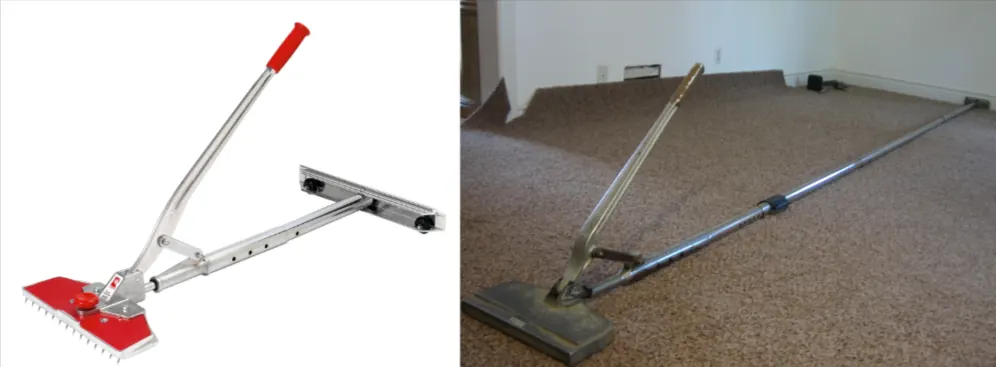
The professional uses sufficient force to stretch the carpet using the power stretcher, ensuring it is smooth and even.
Knee Kicker Usage: Unlike power stretchers, kickers are handheld tools designed for reaching tight spaces such as corners or along walls where a power stretcher cannot go.
A kicker works by using your leg to apply force on one end of the carpet while simultaneously pulling it tight with your hands/arms on the opposite side then tapping with a mallet until wrinkles disappear. This process ensures that you get an even, wrinkle-free surface.
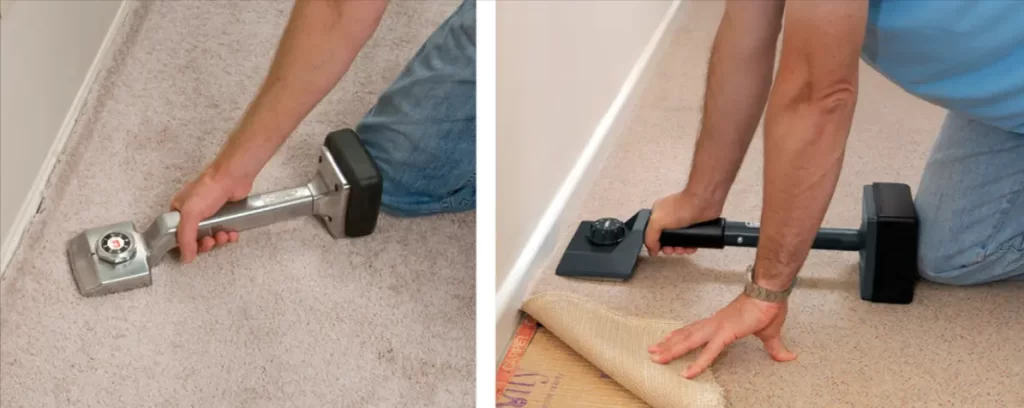
Post-installation carpet stretching is crucial in keeping your carpet looking new and ensuring that it lasts longer than usual.
When you notice any slack spots or wrinkles on your carpet, don’t hesitate to call in a professional for inspection and repair. Carpeting technicians use all needed professional stretching tools and techniques with the appliance of a carpet stretching diagram and etc. The diagram shows you where do you start stretching carpet and the stretching directions from your starting point.
Carpet Power Stretching with the Help of a Carpet Stretching Diagram
—
Carpet Stretching Before and After Comparison
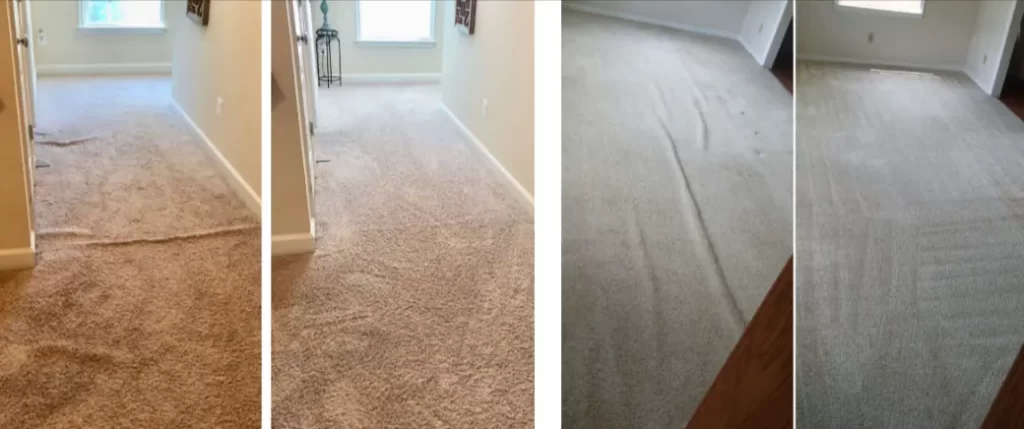
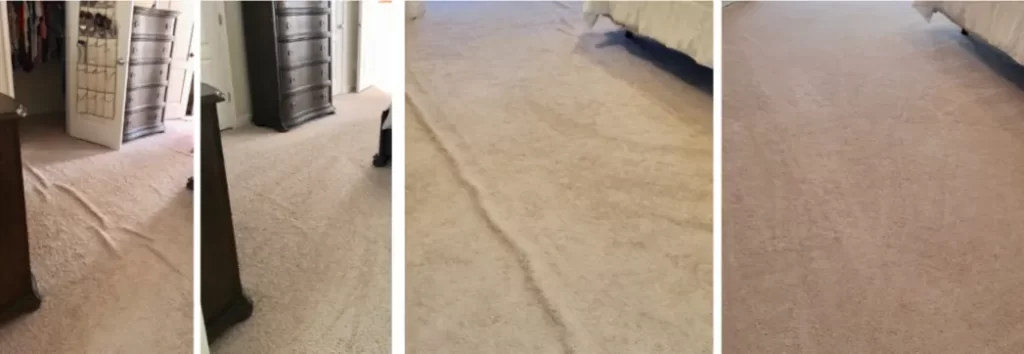

Carpet Stretching Techniques
When it comes to carpet stretching, there are a few different techniques you can use. The two most common methods are the tackless strip method and the carpet knee method.
Both of these methods can be effective when done correctly, but they do have their differences.
Tackless Strip Method
The tackless strip method is probably the most commonly used carpet stretching technique. It involves using strips of wood or metal with small tacks on them to hold the carpet in place.
Here’s what you’ll need:
- Tackless strips
- Hammer
- Pry bar
- Utility knife
To use the tackless strip method, follow these steps:
- Removing old strips – Use a pry bar and hammer to remove any old tackless strips from the subfloor. Be careful not to damage the subfloor.
- Preparing the subfloor – Vacuum and clean the subfloor thoroughly. Make sure it is completely dry before moving on.
- Laying new strips – Cut your new tackless strips to fit each wall and nail them into place along the perimeter of your room.
- Securing strips in place – Once your new strips are in place, stretch your carpet over them and use a knee kicker or power stretcher to make sure it’s tight.
Carpet Knee Method
The carpet knee method involves using your own body weight to stretch the carpet.
Here’s what you’ll need:
Carpet knee kicker: To use this method, simply position yourself on one end of the room and use your knee to kick against a padded end of the tool while stretching and pushing down with your hands at a filling point along the edge of the wall where the tool cannot reach until you’ve stretched all four sides.
How to use knee kicker for carpet stretching
—
Should Carpet Be Cleaned Before or After Stretching?
When it comes to carpet stretching and cleaning, the recommended order is to clean the carpet before stretching it.
Why?
Imagine you have a carpet that is dirty or stained. If you stretch it first and then clean it, there is a chance that the cleaning process could cause the carpet to shrink slightly. This can result in wrinkles or buckling in the newly stretched carpet, undoing the work you just did.
On the other hand, by cleaning the carpet before stretching, you remove any dirt, stains, or debris that could interfere with the stretching process. A clean carpet allows for smoother and more effective stretching, ensuring a better and longer-lasting result.
Think of it this way: it’s like ironing a shirt. You wouldn’t want to iron a dirty shirt because the heat could set in the stains, making them harder to remove later. Similarly, cleaning the carpet first ensures that you have a fresh canvas to work with when stretching it.
So, to achieve the best outcome, it’s recommended to clean your carpet before scheduling a professional carpet stretching service. This way, you can enjoy a clean, properly stretched carpet that looks and feels great in your home.
Is it Cheaper to Stretch Carpet or Replace?
When deciding between stretching the carpet or replacing it, the cost factor plays a significant role.
Generally, stretching the carpet is more cost-effective than replacing it entirely. Stretching involves re-tightening the existing carpet to eliminate wrinkles, bulges, or loose areas. This process typically requires professional equipment, such as a power stretcher, knee kicker, and carpet cutter.
While the exact cost varies based on the size of the room and the severity of the stretching issue, stretching is generally a more budget-friendly option.
To illustrate with a real-life example, imagine you have a living room with a carpet that has developed some wrinkles and loose areas over time. Hiring a professional to stretch the carpet may cost you a few hundred dollars, depending on the size of the room. However, replacing the entire carpet would involve additional expenses, including the cost of new carpet material, removal and disposal of the old carpet, and installation fees. This could easily amount to several thousand dollars.
Considering the significant price difference between stretching and replacing, stretching the carpet becomes a more attractive choice for budget-conscious individuals.
However, it’s important to note that the decision ultimately depends on the condition of the carpet, its age, and personal preferences.
Consulting with a professional can provide a more accurate assessment of whether stretching or replacing is the most suitable and cost-effective option for your specific situation.
Conclusion
Stretching your carpets before and after installation is crucial for ensuring that they look and feel their best. While it may be tempting to skip this step, doing so could result in a wrinkled, uneven carpet that won’t last as long as it should.
By using the right techniques and tools, you can stretch your carpets effectively and enjoy a beautiful, long-lasting floor covering for years to come.
So go ahead and give it a try – your floors will thank you!
